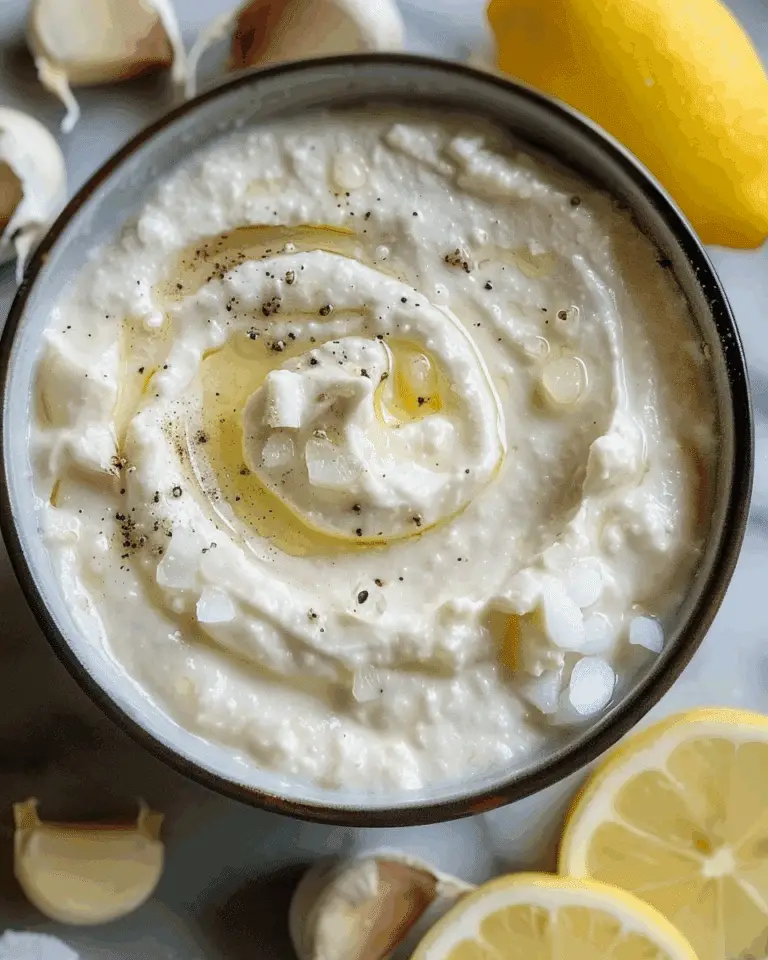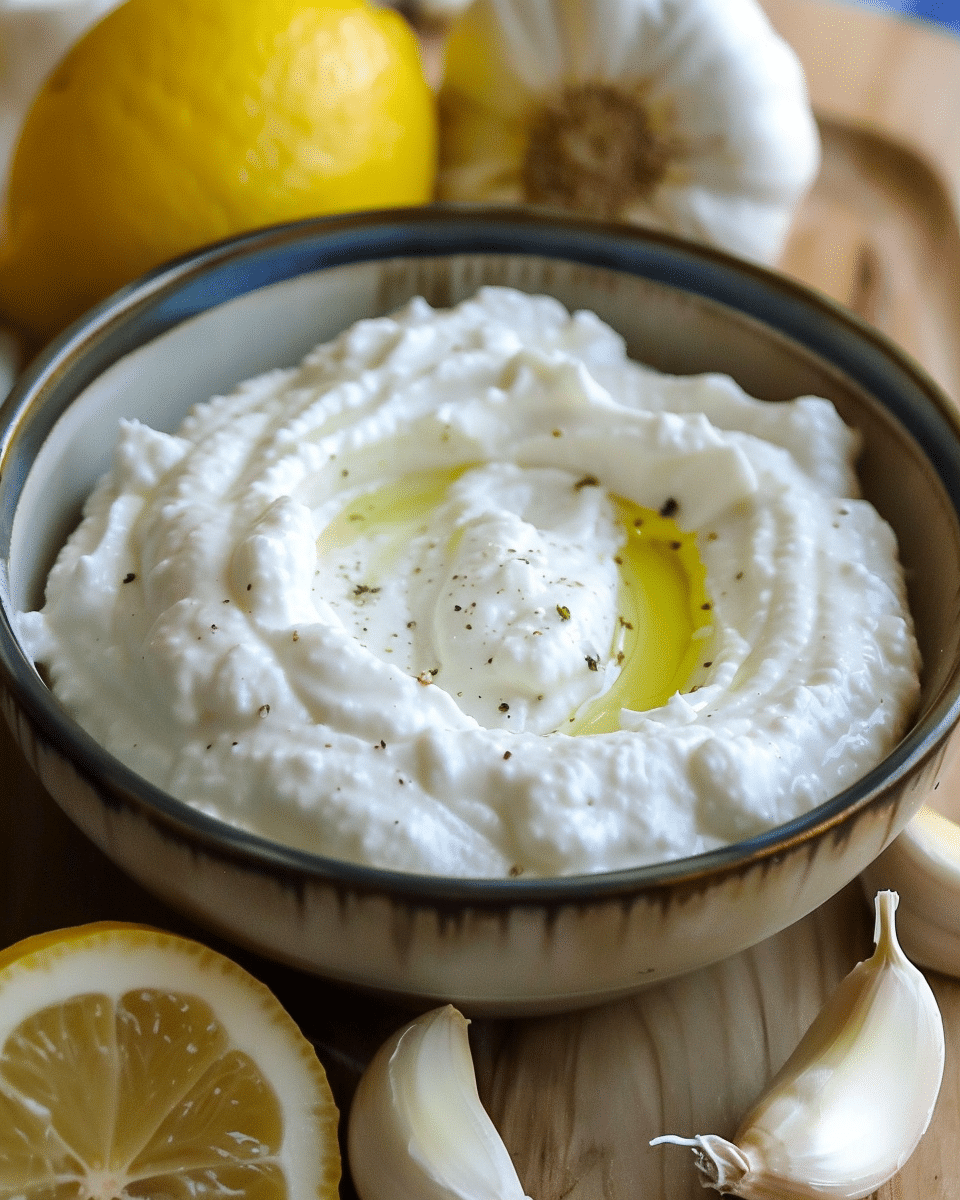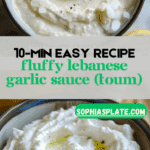Toum, the iconic Lebanese garlic sauce, is a culinary marvel that transforms simple ingredients into a fluffy, cloud-like condiment with an intensely aromatic garlic punch. This traditional sauce has been a staple in Lebanese cuisine for generations, elevating everything from grilled meats to vegetable platters with its distinctive flavor profile.
Why You’ll Love This Recipe
This Lebanese garlic sauce recipe delivers an authentic taste of Middle Eastern cuisine right in your own kitchen. You’ll love how this sauce transforms ordinary dishes into extraordinary meals with its creamy texture and bold garlic flavor. The beauty of toum lies in its simplicity—just a handful of basic ingredients create something truly magical. This recipe yields a perfectly emulsified, snow-white sauce that’s both lighter than air and packed with flavor. Best of all, it’s completely customizable to your taste preferences and requires no cooking whatsoever!
Ingredients
(Tip: You’ll find the full list of ingredients and measurements in the recipe card below.)
Garlic forms the star and foundation of toum, providing that distinctive pungent flavor that defines this sauce. Fresh garlic cloves are essential—the fresher, the better for the most vibrant flavor. Try to select firm, plump bulbs without any green sprouts (which can add bitterness).
Lemon juice adds brightness and acidity that balances the garlic’s intensity. It also plays a crucial role in the emulsification process. Fresh-squeezed lemon juice yields the best flavor, but bottled can work in a pinch.
Olive oil contributes a fruity, complex flavor component to the sauce. Use a mild to medium-intensity olive oil rather than an extra-virgin variety that might overpower the other flavors or make the sauce too bitter.
Vegetable oil creates the neutral base that allows the garlic flavor to shine through. Its mild taste and light texture are perfect for achieving that fluffy, cloud-like consistency that toum is known for.
Salt enhances all the flavors and brings balance to the sauce. It helps to draw out moisture from the garlic and assists in breaking down the cell walls.
Ice cubes play a surprisingly important technical role in this recipe. They help maintain a cool temperature during processing, which is crucial for proper emulsification. The cold temperature prevents the sauce from separating as it’s being whipped to its characteristic fluffiness.
Directions
- Begin by placing the peeled garlic cloves in a food processor and pulse until they’re finely minced. Make sure to scrape down the sides of the bowl occasionally to ensure even processing.
- With the food processor running continuously, slowly drizzle in the lemon juice in a thin stream. This slow addition is crucial for starting the emulsification process.
- Continuing with the processor running, alternate between slowly drizzling in small amounts of olive oil and vegetable oil. The key word here is “slowly”—adding the oil too quickly can cause the emulsion to break.
- Once all oils have been incorporated and the mixture has begun to thicken and become creamy, add the salt.
- Finally, add the ice cubes while the processor is still running, and continue blending until the sauce becomes white, fluffy, and smooth—it should have the consistency of a light, airy mayonnaise.
- Transfer to a serving dish to enjoy immediately, or store in an airtight container for later use.
Servings and Timing
This recipe yields approximately 8 servings (about 2 cups of sauce), making it perfect for family meals or small gatherings. Preparation takes just 10 minutes, with zero cooking time required—it’s truly a no-cook wonder! Each serving contains approximately 120 calories. The sauce can be made ahead of time, making it an excellent option for meal prep or party planning.
Variations
Mild Toum: For those who find the garlic intensity overwhelming, blanch the garlic cloves in boiling water for 30 seconds before processing to mellow the flavor.
Herb-Infused Toum: Add fresh herbs like parsley, mint, or cilantro for a green-tinted variation with added flavor complexity.
Spicy Toum: Incorporate a small amount of chili flakes or a dash of cayenne pepper for a sauce with a subtle heat.
Citrus Twist: Replace some or all of the lemon juice with lime juice for a slightly different citrus profile.
Roasted Garlic Toum: Use roasted garlic instead of raw for a sweeter, more mellow garlic flavor—perfect for those who want the garlic experience without the intensity.
Storage/Reheating
Toum can be stored in an airtight container in the refrigerator for up to 2 weeks. The sauce may separate slightly during storage—this is normal. For best results, let it come to room temperature for about 15 minutes before serving, and give it a gentle stir if needed.
This sauce does not require reheating as it’s traditionally served cold or at room temperature. In fact, heating toum would actually break down its delicate structure and diminish its distinctive flavor.
For longer storage, you can freeze toum in small portions (ice cube trays work well) for up to 3 months. Thaw overnight in the refrigerator before use.
Remember that the garlic flavor will intensify over the first day or two after making the sauce, so if you’re preparing it for guests, consider making it a day ahead for maximum flavor development.
FAQs
Why did my toum sauce break or separate?
The most common reason for toum breaking is adding the oil too quickly. The emulsification process requires slow, steady addition of liquids. Other factors might include using old garlic, not having all ingredients at the same temperature, or overheating during processing. If your sauce does break, try saving it by starting with a new garlic clove in the processor and slowly incorporating the broken sauce.
Can I use a blender instead of a food processor?
Yes, a blender can work, particularly an immersion blender. However, food processors generally produce the best results because they allow for more control over the emulsification process. If using a blender, be extra careful to add oils extremely slowly.
Is toum the same as aioli?
While similar in appearance and use, traditional toum contains no eggs, unlike many aioli recipes. Toum relies solely on the natural emulsifying properties of garlic, making it lighter and more intensely garlic-flavored than aioli.
How can I make my toum less intense?
If you find the garlic flavor too potent, you can blanch the garlic cloves before using them by briefly boiling them for 30 seconds, which removes some of the sharpness. Alternatively, you can add a small boiled potato to the mixture, which will dilute the garlic intensity without significantly altering the texture.
Can I use all olive oil instead of vegetable oil?
While technically possible, using all olive oil will result in a more bitter-tasting sauce with a heavier texture. The combination of neutral vegetable oil and olive oil creates the ideal balance of flavor and lightness.
What if I don’t have ice cubes?
Ice-cold water can substitute for ice cubes, but use slightly less to maintain the proper consistency. The important factor is keeping the mixture cool during processing.
What can I serve with toum?
Toum is traditionally served with grilled meats like shish tawook (chicken skewers) or shawarma. It’s also delicious with roasted vegetables, as a spread on sandwiches, mixed into hummus, or as a dip for fresh bread or fries.
Why is my toum not turning white and fluffy?
This usually indicates an emulsion problem. Make sure you’re starting with completely dry equipment (any water can prevent proper emulsification), adding the oil extremely slowly, and keeping all ingredients at similar temperatures.
Is toum healthy?
Toum contains heart-healthy oils and garlic, which has numerous health benefits including immune-boosting properties. However, it is calorie-dense due to the oil content, so moderation is key. The raw garlic provides significant antioxidant and antimicrobial benefits.
Can I make toum without a food processor or blender?
While traditional methods used a mortar and pestle for making toum, it requires significant arm strength and time. The modern appliance method yields more consistent results for home cooks. If attempting by hand, be prepared for an intensive arm workout!
Conclusion
Lebanese Toum is more than just a condiment—it’s a culinary tradition that brings the bold, vibrant flavors of Lebanon to your table. The magical transformation of simple ingredients into a cloud-like sauce is both a science and an art, resulting in an unforgettable flavor experience. Whether you’re serving it alongside grilled meats, using it as a sandwich spread, or discovering new applications, this garlic sauce adds an authentic touch of Middle Eastern cuisine to any meal. Master this recipe, and you’ll have an impressive, versatile condiment in your culinary repertoire that’s sure to become a household favorite. The time invested in carefully emulsifying this sauce pays off with a flavor profile that simply can’t be replicated by any store-bought alternative.
Print
Lebanese Garlic Sauce (Toum)
Lebanese Garlic Sauce (Toum) is a creamy and fluffy garlic-based sauce often served with grilled meats, vegetables, or as a dipping sauce
- Total Time: 10 minutes
- Yield: 8 servings
Ingredients
1 cup garlic, peeled
1/4 cup lemon juice
1/4 cup olive oil
1/4 cup vegetable oil
1 tablespoon salt
1/4 cup ice cubes
Instructions
- Place garlic in a food processor and pulse until finely minced.
- Slowly drizzle in lemon juice, olive oil, and vegetable oil while the processor is running, until the mixture emulsifies.
- Add salt and ice cubes, blending until smooth and fluffy.
- Serve with grilled meats, vegetables, or as a dipping sauce.
Notes
- Use fresh garlic for the best flavor.
- Adjust the amount of lemon juice and salt to taste.
- Ensure oils are added slowly to avoid breaking the emulsion
- Prep Time: 10 minutes
- Cook Time: 0 minutes
- Category: Condiment
- Method: Blending
- Cuisine: Lebanese
- Diet: Vegan


